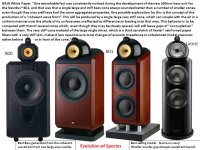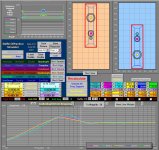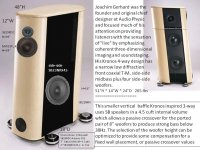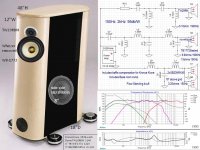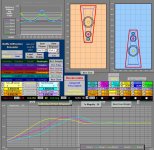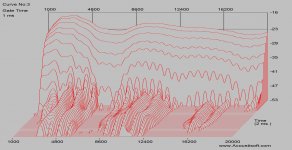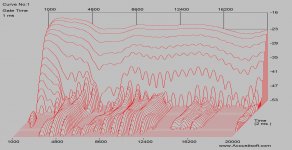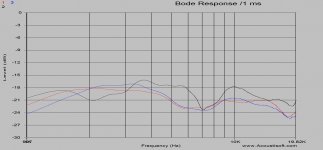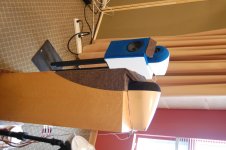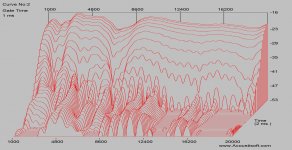Revel Ultima Studio vs JBL M2 ?
I don't understand : does the shape is important below frequencies which are 4 Pi radian (so what about the importance of the speaker shape vs the close walls ?)
If we talk more about towards 2 Pi radian and before tweeter (> 1K Hz to <2 k Hz) : is it still important ? What about the round back shape trade off in relation to the front bafle step ?
Why synergy design should work (and Onken, and Vott, and...) so good without round shapes ?
Just naives questions...sorry, but what are we talking about really ? The room ? The distance from side and front walls with the speakers ? Internal difractions because the round shape ?
http://www.cabasse.com/fr/collection/stereo/sphere/ : what is the most important : co incident radiation speaker or round shape ?!
I don't understand : does the shape is important below frequencies which are 4 Pi radian (so what about the importance of the speaker shape vs the close walls ?)
If we talk more about towards 2 Pi radian and before tweeter (> 1K Hz to <2 k Hz) : is it still important ? What about the round back shape trade off in relation to the front bafle step ?
Why synergy design should work (and Onken, and Vott, and...) so good without round shapes ?
Just naives questions...sorry, but what are we talking about really ? The room ? The distance from side and front walls with the speakers ? Internal difractions because the round shape ?
http://www.cabasse.com/fr/collection/stereo/sphere/ : what is the most important : co incident radiation speaker or round shape ?!
Last edited:
trade offs ? Is it really that important ?
How can we rate it in relation to :
drivers ?
XO ?
room placement ?
electronics & hardware (source, amp, cable, room modes, distance of the listener, distance of the speaker in relation in the walls, furnitures reflections, etc ?)
Hope we are speaking about internal difraction ?! So : round shape vs size variations of the internal cavities size...and bracing ?
How can we rate it to know how important it is and relation with what ? (inetrnal shape ? External shape ?)
How can we rate it in relation to :
drivers ?
XO ?
room placement ?
electronics & hardware (source, amp, cable, room modes, distance of the listener, distance of the speaker in relation in the walls, furnitures reflections, etc ?)
Hope we are speaking about internal difraction ?! So : round shape vs size variations of the internal cavities size...and bracing ?
How can we rate it to know how important it is and relation with what ? (inetrnal shape ? External shape ?)
Waveguides (which direct HF energy forward, less going toward cabinet edges) works too as mentioned earlier in the thread. I think that should be considered in Wayne Parham's comments -- his speakers use waveguides (semi-conical horns), so not a lot of upper mid and treble energy going toward his squared edges.
I've been using waveguides in recent years and the speaker location is hard to identify even when I'm looking right at the things! Particularly when in a 'Synergy'/'Unity' arrangement (with midrange fed into the same waveguide), it can be hard to convince yourself that the sound is actually coming from the speaker. Put some other speaker in between them and EVERYONE will insist that the center speaker is playing till you show them no wires are connected to it.
I've been using waveguides in recent years and the speaker location is hard to identify even when I'm looking right at the things! Particularly when in a 'Synergy'/'Unity' arrangement (with midrange fed into the same waveguide), it can be hard to convince yourself that the sound is actually coming from the speaker. Put some other speaker in between them and EVERYONE will insist that the center speaker is playing till you show them no wires are connected to it.
Waveguides and (back)speaker shapes... does the first is changing the relation to the second as the speed of sound is constant ?
To rephrase it : doses a horn change the game with 4Pi to 2Pi relation between frequencies and speaker shapeS (front bafle, size, width to deep ratio, round shapes etc) ?
How important it is in relation to the rest (the room/car load, place of the listener, etc ?)
To rephrase it : doses a horn change the game with 4Pi to 2Pi relation between frequencies and speaker shapeS (front bafle, size, width to deep ratio, round shapes etc) ?
How important it is in relation to the rest (the room/car load, place of the listener, etc ?)
Horn size has to still be sufficient for the designed-for ?Pi radiation pattern and frequency. But in the range where size is usually already sufficient (upper frequencies in non-tiny speaker boxes), the horn can control it further and keep those frequencies from the cabinet edges. Below those frequencies, the horn does nothing and things go toward omnidirectional per the cabinet width as usual. Cabinet edges of roundover radii that would usually be acceptable in homes only work for upper frequencies, too. Probably doing both (like in the xBush Part Deaux http://www.diyaudio.com/forums/multi-way/297620-xbush-mark-2-synergy-unity-horn-spherical-proportions.html) would be best if you like the cosmetics, but I can't see it making the speaker locations less discernible than the Unity-d waveguide already does.
In relation to the room, it (waveguide) is also a way of working with or against room effects, in effect. It also can provide a way to widen the sweet spot for listener position, so not sure those are things that can be prioritized since it provides a way to in effect work on the same issues.
In relation to the room, it (waveguide) is also a way of working with or against room effects, in effect. It also can provide a way to widen the sweet spot for listener position, so not sure those are things that can be prioritized since it provides a way to in effect work on the same issues.
Last edited:
What Do Roundovers Do?
Evloution of Species:
B&W has excellent engineers and excellent measurement equipment.
-The 800 series used separate cabinets for T-M-W, each with properly sized bevels to reduce diffraction over that driver's frequency range.
-The 801 series introduced sphere+tapered tube enclosures for the M and T with measurements proving their value, and also built a smoother physical interface between the W box and TM sphere.
-The 802 series introduced very large, "almost cylindrical", round overs on the woofer front baffle, and built an even smoother physical interface between the curved W box and TM sphere.
---B&W loves big rounds.
A simple baffle diffraction simulation of "almost cylindrical" round overs for a T-M-W 3-way baffle illustrates low tweeter diffraction effects through the crossover, which should produce a consistent soundstage through the TM crossover. Below the tweeter crossover, both the M and W generate similar 1.8db slow baffle humps, which correctly linearly drop with the baffle W*H dimentional effects. Textbook crossovers perform well with "almost cylindrical" baffles.
---Big round overs = Small diffraction effects = Smooth and Uniform soundstage =??= NEUTRAL?
The tapered-truncated-pyramid cabinet constructed and measured in 1950 by Dr. Harry Olson, and marketed by Avalon usually sounds good and "interesting" in most rooms. Why? A simple baffle diffraction simulation illustrates how the T and M each produce some triangle-bevel diffraction generated dither in their frequency band.
---Deep bevels = reduced but irregular diffraction effects = comfortable yet interesting soundstage =??= CAPTIVATING?
yep....just like an Audio Critic searching for adjectives....
Evloution of Species:
B&W has excellent engineers and excellent measurement equipment.
-The 800 series used separate cabinets for T-M-W, each with properly sized bevels to reduce diffraction over that driver's frequency range.
-The 801 series introduced sphere+tapered tube enclosures for the M and T with measurements proving their value, and also built a smoother physical interface between the W box and TM sphere.
-The 802 series introduced very large, "almost cylindrical", round overs on the woofer front baffle, and built an even smoother physical interface between the curved W box and TM sphere.
---B&W loves big rounds.
A simple baffle diffraction simulation of "almost cylindrical" round overs for a T-M-W 3-way baffle illustrates low tweeter diffraction effects through the crossover, which should produce a consistent soundstage through the TM crossover. Below the tweeter crossover, both the M and W generate similar 1.8db slow baffle humps, which correctly linearly drop with the baffle W*H dimentional effects. Textbook crossovers perform well with "almost cylindrical" baffles.
---Big round overs = Small diffraction effects = Smooth and Uniform soundstage =??= NEUTRAL?
The tapered-truncated-pyramid cabinet constructed and measured in 1950 by Dr. Harry Olson, and marketed by Avalon usually sounds good and "interesting" in most rooms. Why? A simple baffle diffraction simulation illustrates how the T and M each produce some triangle-bevel diffraction generated dither in their frequency band.
---Deep bevels = reduced but irregular diffraction effects = comfortable yet interesting soundstage =??= CAPTIVATING?
yep....just like an Audio Critic searching for adjectives....
Attachments
Have you read the marketing material that B&W has? They tell about the benefits of rounded baffles and boxes by many nice words. I wonder why the xo designer has been kept unaware of this?
I have heard the latest 800 and 802, they do not sound bad, but not neutral either. Iam sorry to say that I have never heard a Magico.
I have heard the latest 800 and 802, they do not sound bad, but not neutral either. Iam sorry to say that I have never heard a Magico.
How can we rate it in relation to :
drivers ?
XO ?
room placement ?
You know how scientists make experiments to find out the truth. Make two identical sets of speakers with only one difference that you'd like to inspect and do a DBT.
Waveguides (which direct HF energy forward, less going toward cabinet edges) works too as mentioned earlier in the thread. I think that should be considered in Wayne Parham's comments -- his speakers use waveguides (semi-conical horns), so not a lot of upper mid and treble energy going toward his squared edges.
I've been using waveguides in recent years and the speaker location is hard to identify even when I'm looking right at the things! Particularly when in a 'Synergy'/'Unity' arrangement (with midrange fed into the same waveguide), it can be hard to convince yourself that the sound is actually coming from the speaker. Put some other speaker in between them and EVERYONE will insist that the center speaker is playing till you show them no wires are connected to it.
The phantom centre isn't the true benefit of the anti diffraction measures if you ask me. The disappearing act of the speakers has more to do with the stage extending beyond the speaker's width if it's in the recording i.m.h.o.
With that phase shuffler I mentioned the goal was to get the phantom centre's tonal balance in line with the sides. (totally different subject) The side effect of those first shufflers I mentioned was the panned material (left and right) kind of stuck to speaker locations. The panthom centre wasn't effected like that, it still came from the centre only. It did seem to move back a bit.
My stage can be wide or narrow depending on which song I play, at no point you hear where in that stage the placement of the speaker is. This works with eyes open, but even better with eyes closed. Our eyes are pretty strong compared to what the ears hear, at least mine are. The phantom centre never suffers from that. Like you said, it's hard to believe the speakers are playing at all. Mono recordings give absolutely no clue at all the speakers do anything.
But the true test isn't the phantom centre, it's the side material being totally independent from the speaker location. You just hear the instruments and voices hanging in air independent from each other, seamlessly placed along the stage in a 3D manor and not indicating the speaker location in that process.
On some songs it is wide, some songs have sound coming from the sides, in front of the speakers, with eyes closed I simply cannot point out their position based on what I hear.
With that disappearing act, the right tonal balance, bottom end extension and depth of stage it's much like being "right there".
I bet even speakers with the worst diffraction effects can still pull off the phantom centre properly.
"Image" localization is a function of what Blauert calls "Summing Localization" that occurs very early on in the auditory perception of hearing, By a few ms. its over. But within those first few ms the signal needs to be clean and free from aberrations. Close-by diffractions from things such as cabinet edges will create delayed signals within this first few ms region. Hence, even though the effects may be small in the far field, they can be major to the formation of phantom images. And I would like to point out that negative diffractions can occur from other things in the room not just the speaker edges. And none of these effects can be "EQ'd" since they are not minimum phase and differ with seating location.
I have found that intense attention to nearby diffractions is necessary to evaluating cabinet diffraction. If the whole setup is diffracting like crazy one is never going to hear a change in the cabinet edge situation.
Also, stereo is an essential requirement in any imaging tests since there is no phantom image from a mono setup. Doing a valid subjective test of cabinet edge diffraction would be extremely difficult to do. A "simple" test is likely to be invalid.
And lets keep in mind that diffraction can be thought of as a secondary source. This is why mouth diffraction in a waveguide will cause internal resonances along the length of the device from the edge diffraction wave that travels back down the waveguide. These can be quite audible. So if one had a waveguide with sharp edges, the diffraction of those edges would likely completely mask the audibility of the cabinet edges. It would be impossible to differentiate the audibility of a waveguide resonance from the audibility of its edge diffraction since the two things are completely correlated.
My experience is that serious attention to any and all nearby diffractions in a sound setup enhance imaging.
I have found that intense attention to nearby diffractions is necessary to evaluating cabinet diffraction. If the whole setup is diffracting like crazy one is never going to hear a change in the cabinet edge situation.
Also, stereo is an essential requirement in any imaging tests since there is no phantom image from a mono setup. Doing a valid subjective test of cabinet edge diffraction would be extremely difficult to do. A "simple" test is likely to be invalid.
And lets keep in mind that diffraction can be thought of as a secondary source. This is why mouth diffraction in a waveguide will cause internal resonances along the length of the device from the edge diffraction wave that travels back down the waveguide. These can be quite audible. So if one had a waveguide with sharp edges, the diffraction of those edges would likely completely mask the audibility of the cabinet edges. It would be impossible to differentiate the audibility of a waveguide resonance from the audibility of its edge diffraction since the two things are completely correlated.
My experience is that serious attention to any and all nearby diffractions in a sound setup enhance imaging.
Last edited:
I don't see synergy as contributing to this, but a lack of diffraction. In fact this is the tradeoff, as I see it in putting holes in a waveguide. This further boils down to where you can cross.the speaker location is hard to identify even when I'm looking right at the things! Particularly when in a 'Synergy'/'Unity' arrangement (with midrange fed into the same waveguide)
^Sorry I jus choose normalized polars for comparison, we shoul dlook at the small variation only to see diffractions but let us look other measurements too. Those polars definitely aren't 1/3 smoothed, more like 1/12.
These are on-axis at 50" (125cm) distance at tweeter axis for tweeter, nearfield for mid and bass. Other problem because of nearfield not showing baffle effects.
The clou of this thread is spherical baffle and generous roundovers, which B&W's tweeter and mid do fullfill. The point is that obviously this design/shape is not an easy way to smoothness... Guess which is B&W and which Magico!
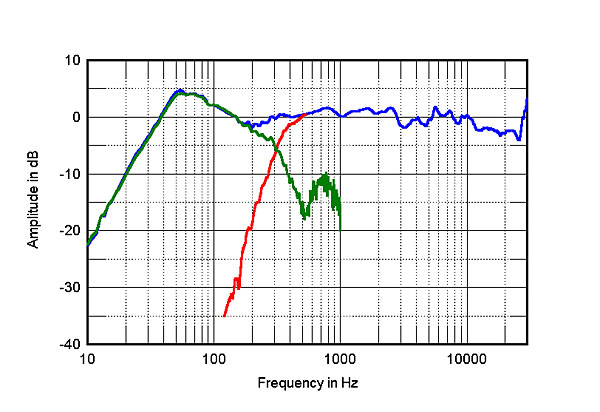
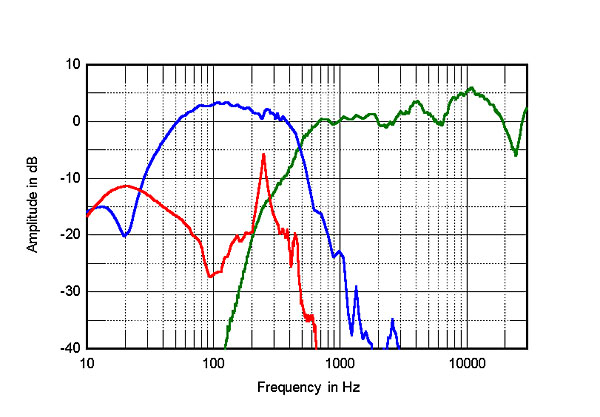
I always think B&W's artificial big sound stage is mostly due to 10K boost they have been doing since Nautilus, not due to that round shape marketing thingy with diamond blah blah. Anyway, Magico sounds much better than B&W to my ears.
While those round edge speakers are popular for consumer speakers, for professional studio monitors, sharp edged or very slightly rounded edged baffle are still mainstream, except cheap prosumer models. ex. Amphion, Dynaudio, ATC, Proac, PMC, Quested, Geithain, Barefoot, Neumann, Yamaha...
Genelec actually lost popularity when they released the current round edge models.
I feel that those aggressively round edged "high end" speakers are nothing but cosmetic. Baffle edge diffraction is not that important or could even be a good thing. I really like the consumer speakers with sharp edge, such as ATC, Spendor, Orangutan, and they do sound more enjoyable than many round shaped speakers with lifeless sound. This would be probably because I have been working with professional monitors for long, and accustomed to them...
Genelec actually lost popularity when they released the current round edge models.
I feel that those aggressively round edged "high end" speakers are nothing but cosmetic. Baffle edge diffraction is not that important or could even be a good thing. I really like the consumer speakers with sharp edge, such as ATC, Spendor, Orangutan, and they do sound more enjoyable than many round shaped speakers with lifeless sound. This would be probably because I have been working with professional monitors for long, and accustomed to them...
Last edited:
I wrote a paper about creating directivity a time ago in which I tried to separate and all principles and created many examples. Please take a look at page 12 (only in german, but the simulation speak for themselves  ). There are simulation of spherical and cylindrical enclosures. The sphericals show how the baffle step affects directivity (because a sphere has no edges there is no edge diffraction). The cylindricals on th eother side show how edge diffraction affects directivity.
). There are simulation of spherical and cylindrical enclosures. The sphericals show how the baffle step affects directivity (because a sphere has no edges there is no edge diffraction). The cylindricals on th eother side show how edge diffraction affects directivity.
Last edited:
I believe wesayso is on the right track here. If I'm seeing it right, His phase shuffler is operating in the 0-0.5ms range, when the baffle reflections occur.
I designed tweeter holders and have plans for a 3way with a rounded baffle for midrange driver. I do think a minimum flat portion is necessary before roundover begins and would like to study this more.
Having owned Nautilus 801 for 2 years, I can say they are a disaster in several ways but one issue I believe is that the tweeter and mid holders do not have flat baffles at all, and the dome and cone meet at the start of the roundover. It looks refined but I believe It's all about cosmetics, and Nautilus- ReallY?
Maybe nothing new, but here is 3 measurements with the same tweeter at 0.2M with 1msec of reflections. Red=rounded holder and felt - Blue=Free air(normal tweeter faceplate only) Black= Tweeter at top center of 10"X16" flat baffle.
FR at the back wall(t=0)of the waterfall plot is the same curve as Bode.
Seems like we need to look at >1msec.
IME rounded baffles creates extreme openness(N801 included) and a better unveiling of recorded details.
I designed tweeter holders and have plans for a 3way with a rounded baffle for midrange driver. I do think a minimum flat portion is necessary before roundover begins and would like to study this more.
Having owned Nautilus 801 for 2 years, I can say they are a disaster in several ways but one issue I believe is that the tweeter and mid holders do not have flat baffles at all, and the dome and cone meet at the start of the roundover. It looks refined but I believe It's all about cosmetics, and Nautilus- ReallY?
Maybe nothing new, but here is 3 measurements with the same tweeter at 0.2M with 1msec of reflections. Red=rounded holder and felt - Blue=Free air(normal tweeter faceplate only) Black= Tweeter at top center of 10"X16" flat baffle.
FR at the back wall(t=0)of the waterfall plot is the same curve as Bode.
Seems like we need to look at >1msec.
IME rounded baffles creates extreme openness(N801 included) and a better unveiling of recorded details.
Attachments
Many believe though it's possible to EQ what's non minimum phase with a FIR filter, since a FIR filter is not married to phase.And I would like to point out that negative diffractions can occur from other things in the room not just the speaker edges. And none of these effects can be "EQ'd" since they are not minimum phase and differ with seating location.
- Status
- This old topic is closed. If you want to reopen this topic, contact a moderator using the "Report Post" button.
- Home
- Loudspeakers
- Multi-Way
- What Do Roundovers Do?
